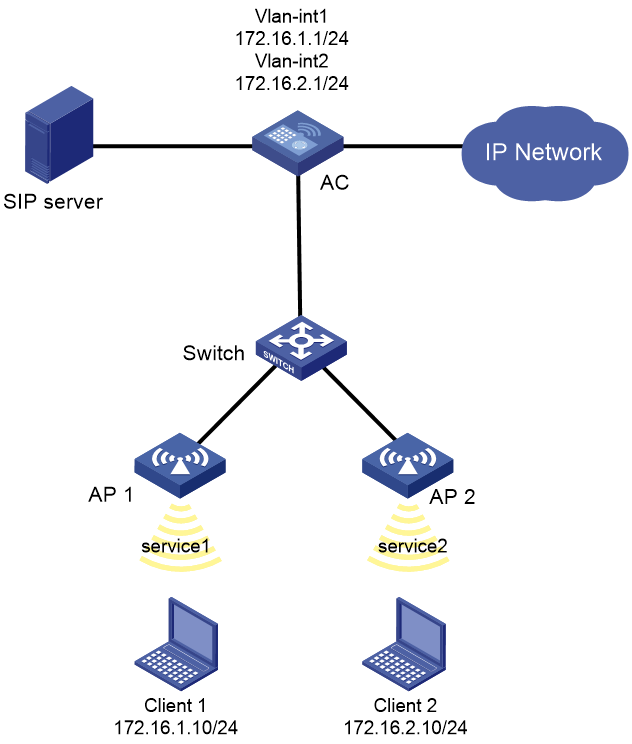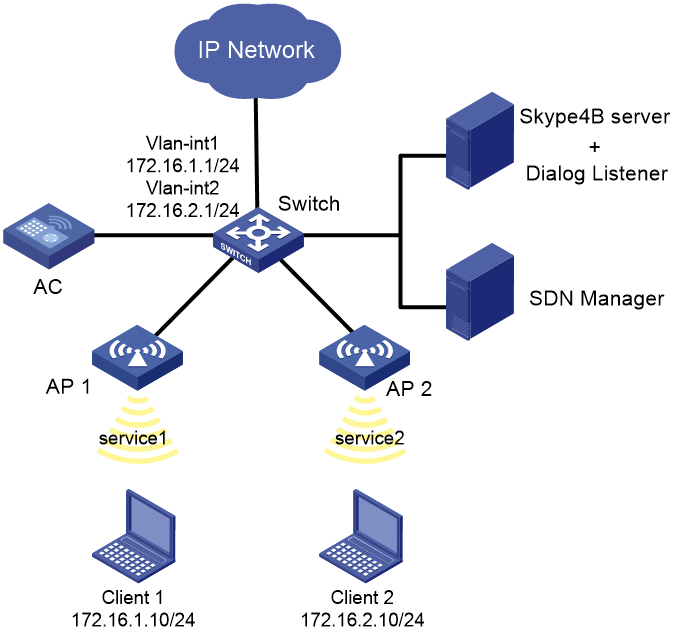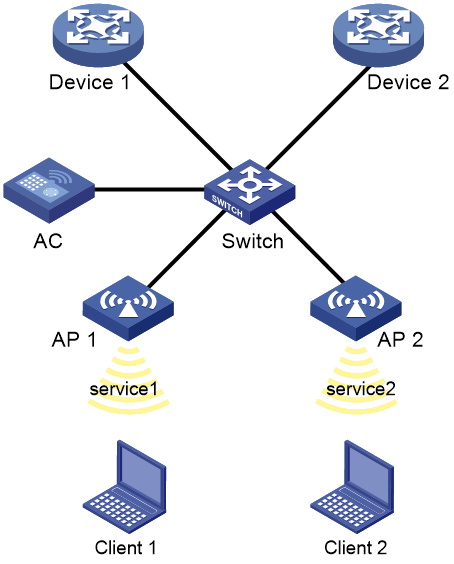- Table of Contents
-
- 20-Network Management and Monitoring Configuration Guide
- 00-Preface
- 01-System maintenance and debugging configuration
- 02-NQA configuration
- 03-SNMP configuration
- 04-RMON configuration
- 05-NETCONF configuration
- 06-EAA configuration
- 07-Process monitoring and maintenance configuration
- 08-Flow log configuration
- 09-Packet capture configuration
- 10-Mirroring configuration
- 11-Fast log output configuration
- 12-UCC configuration
- 13-SQA configuration
- Related Documents
-
| Title | Size | Download |
|---|---|---|
| 12-UCC configuration | 174.83 KB |
Restrictions: Hardware compatibility with UCC
UCC configuration tasks at a glance
Configuring UCC for an audio or video application
Enabling UCC for an audio or video application
Configuring priority marking for traffic from an audio or video application
Configuring UCC AP and AP group white lists
Display and maintenance commands for UCC
Example: Configuring SIP-based UCC
Configuring UCC
About UCC
Unified Communication and Collaboration (UCC) can identify packets of specific protocols and increase the priority of the packets accordingly to accelerate packet forwarding and improve user experience.
Restrictions: Hardware compatibility with UCC
Support for this feature depends on the AC model and AP model.
The following compatibility matrixes show the support of ACs for UCC:
|
Hardware series |
Model |
Product code |
UCC compatibility |
|
WX1800H series |
WX1804H-PWR |
EWP-WX1804H-PWR-CN |
No |
|
WX2500H series |
WX2508H-PWR-LTE WX2510H-PWR WX2510H-F-PWR WX2540H WX2540H-F WX2560H |
EWP-WX2508H-PWR-LTE EWP-WX2510H-PWR EWP-WX2510H-F-PWR EWP-WX2540H EWP-WX2540H-F EWP-WX2560H |
No |
|
MAK series |
MAK204 MAK206 |
EWP-MAK204 EWP-MAK206 |
No |
|
WX3000H series |
WX3010H WX3010H-X-PWR WX3010H-L-PWR WX3024H WX3024H-L-PWR WX3024H-F |
EWP-WX3010H EWP-WX3010H-X-PWR EWP-WX3010H-L-PWR EWP-WX3024H EWP-WX3024H-L-PWR EWP-WX3024H-F |
No |
|
WX3500H series |
WX3508H WX3508H WX3510H WX3510H WX3520H WX3520H-F WX3540H WX3540H |
EWP-WX3508H EWP-WX3508H-F EWP-WX3510H EWP-WX3510H-F EWP-WX3520H EWP-WX3520H-F EWP-WX3540H EWP-WX3540H-F |
Yes |
|
WX5500E series |
WX5510E WX5540E |
EWP-WX5510E EWP-WX5540E |
Yes |
|
WX5500H series |
WX5540H WX5560H WX5580H |
EWP-WX5540H EWP-WX5560H EWP-WX5580H |
Yes |
|
Access controller modules |
LSUM1WCME0 EWPXM1WCME0 LSQM1WCMX20 LSUM1WCMX20RT LSQM1WCMX40 LSUM1WCMX40RT EWPXM2WCMD0F EWPXM1MAC0F |
LSUM1WCME0 EWPXM1WCME0 LSQM1WCMX20 LSUM1WCMX20RT LSQM1WCMX40 LSUM1WCMX40RT EWPXM2WCMD0F EWPXM1MAC0F |
Yes |
|
Hardware series |
Model |
Product code |
UCC compatibility |
|
WX1800H series |
WX1804H-PWR WX1810H-PWR WX1820H WX1840H |
EWP-WX1804H-PWR EWP-WX1810H-PWR EWP-WX1820H EWP-WX1840H-GL |
No |
|
WX3800H series |
WX3820H WX3840H |
EWP-WX3820H-GL EWP-WX3840H-GL |
Yes |
|
WX5800H series |
WX5860H |
EWP-WX5860H-GL |
Yes |
UCC configuration tasks at a glance
To configure UCC, perform the following tasks:
· Configuring Skype4B-based UCC
· Configuring UCC for an audio or video application
Perform the following tasks:
¡ Enabling UCC for an audio or video application
¡ Configuring priority marking for traffic from an audio or video application
· Configuring UCC AP and AP group white lists
Configuring SIP-based UCC
About this task
SIP-based UCC enables the device to identify SIP protocol packets from wireless clients and preferentially forward audio and video traffic for the wireless clients.
Restrictions and guidelines
SIP-based UCC does not support analysis of encrypted SIP protocol packets or fragments.
Procedure
1. Enter system view.
system-view
2. Create a UCC profile and enter its view.
ucc profile profile-name
3. Enable SIP-based UCC in the UCC profile.
sip enable
By default, SIP-based UCC is disabled for a UCC profile.
4. Return to system view.
quit
5. Enter service template view.
wlan service-template service-template-name
6. Bind a UCC profile to the service template.
ucc-profile profile-name
By default, no UCC profile is bound to a service template.
Configuring Skype4B-based UCC
About this task
Skype for Business (Skype4B)-based UCC enables the device to analyze Skype4B packets from wireless clients and preferentially forward the audio, video, and application sharing traffic for the wireless clients
Procedure
1. Enter system view.
system-view
2. Enable the device to communicate with the Skype4B server and specify the port number.
skype4b listener { http-port http-port-num | https-port https-port-num ssl-policy ssl-policy-name }
Make sure the port numbers are different if you configure both HTTP and HTTPS services.
3. Create a UCC profile and enter its view.
ucc profile profile-name
4. Enable Skype4B-based UCC.
skype4b enable
By default, Skype4B-based UCC is disabled.
5. (Optional.) Configure priority marking for Skype4B application sharing packets.
skype4b app-share remark { dscp dscp-value | dot1p dot1p-value }
6. (Optional.) Configure priority marking for Skype4B video packets.
skype4b video remark { dscp dscp-value | dot1p dot1p-value }
By default, the DSCP value is 34 and the 802.1p priority is 4 for Skype4B video packets.
7. (Optional.) Configure priority marking for Skype4B voice packets.
skype4b voice remark { dscp dscp-value | dot1p dot1p-value }
By default, the DSCP value is 46 and the 802.1p priority is 6 for Skype4B voice packets.
Configuring UCC for an audio or video application
Enabling UCC for an audio or video application
About this task
With UCC enabled for an audio or video application, the wireless service bound to the UCC profile will preferentially forward traffic from that application for wireless users that use the application to obtain higher-quality services.
Restrictions and guidelines
This feature is available only in local forwarding mode.
Procedure
1. Enter system view.
system-view
2. Create a UCC profile and enter its view.
ucc profile profile-name
3. Enable UCC for an audio or video application.
application app-name enable
By default, UCC is disabled for audio and video applications.
4. Return to system view.
quit
5. Create a service template and enter its view.
wlan service-template service-template
6. Bind the service template to a UCC profile.
ucc-profile profile-name
Configuring priority marking for traffic from an audio or video application
About this task
Priority marking marks the priority of uplink traffic for an audio or video application and sends the priority to other service modules for them to process the traffic as configured.
Procedure
1. Enter system view.
system-view
2. Create a UCC profile and enter its view.
ucc profile profile-name
3. Configure priority marking for traffic from an audio or video application.
application app-name flow-mark
By default, priority marking is not configured for traffic from audio and video applications.
4. Create a service template and enter its view.
wlan service-template service-template
5. Bind the service template to a UCC profile.
ucc-profile profile-name
Configuring UCC AP and AP group white lists
About this task
Perform this task to allow only APs that belong to the UCC AP or AP group white list to collect and report UCC statistics to AC, reducing AC pressure from too many AP reports. In this way, pressure is also released for APs that do not belong to the UCC AP or AP group white list, because they no longer collect or report UCC statistics to AC.
Restrictions and guidelines
Only UCC APs for audio and video traffic are restricted by the white list.
Procedures (AP white list)
1. Enter system view.
system-view
2. Configure the UCC AP white list.
ucc whitelist ap ap-name
Procedures (AP group white list)
1. Enter system view.
system-view
2. Configure the UCC AP group white list.
ucc whitelist ap ap-name
Display and maintenance commands for UCC
Execute display commands in any view.
|
Command |
|
|
Display UCC profile information. |
display ucc profile [ profile-name ] |
|
Display UCC entries. |
display ucc table |
|
Display UCC AP white list information. |
display ucc whitelist ap |
|
Display UCC AP group white list information. |
display ucc whitelist ap-group |
|
Clear UCC entries. |
reset ucc table [ sip | skype4b ] |
UCC configuration examples
Example: Configuring SIP-based UCC
Network configuration
As shown in Figure 1, the SIP server installed with third-party VoIP server software acts as both the SIP agent server and SIP registration server to manage SIP user registration and respond to user calls. Client 1 and Client 2 use the AC as their gateway, and they can call each other through the client software installed on them. Centralized forwarding is configured.
Configure UCC to optimize multimedia traffic between the clients.
Procedure
1. Assign IP addresses to interfaces, as shown in Figure 1. (Details not shown.)
2. Verify that the APs can associate with the AC and the clients can obtain an IP address.
3. Configure the SIP server:
Install third-party VoIP server software, and configure a username (telephone number) and password for the clients.
4. Configure Client 1 and Client 2:
Install third-party VoIP client software, specify the IP address of the SIP server, username (telephone number), password, and other parameters.
5. Configure the AC:
# Create UCC profile 1, and enable SIP-based UCC in the UCC profile.
<Sysname> system-view
[Sysname] ucc profile 1
[Sysname-ucc-profile-1] sip enable
[Sysname-ucc-profile-1] quit
# Bind the UCC profile to service template service1.
[Sysname] wlan service-template service1
[Sysname-wlan-st-service1] ucc-profile 1
[Sysname-wlan-st-service1] quit
# Bind the UCC profile to service template service2.
[Sysname] wlan service-template service2
[Sysname-wlan-st-service2] ucc-profile 1
[Sysname-wlan-st-service2] quit
Verifying the configuration
# Place a call from Client 1 to Client 2. (Details not shown.)
# Execute the following command to verify that multimedia traffic has been forwarded from Client 1 to Client 2.
[Sysname] display ucc table
UCC tuple5 entry info:
Source IP/port : 172.16.1.10/11111
Destination IP/port : 172.16.2.10/22222
Transport layer protocol : UDP
Flow type : SIP
Media type : Audio
Lifetime : 280
Total tuple5 entries found : 1
Total tuple3 entries found : 0
Total entries found: 1
Example: Configuring Skype4B-based UCC
Network configuration
As shown in Figure 2, all network users use Skype4B for communication.
The Skype4B server (including front-end and back-end) manage user registration and calls, and the Dialog Listener listens for Skype dialogs on the AC. The two servers are deployed on the same physical server.
The SDN Manager obtains dialog information from the Dialog Listener and establishes an HTTP or HTTPs connection with the AC to issue dialog information.
The AC is the client traffic forwarder, and the switch is the gateway for the clients. The clients use Skype4B client software to place calls to each other.
Configure Skype4B-based UCC on the AC to optimize Skype4B traffic between the clients to provide high-quality Skype4B services.
Prerequisites
Assign IP addresses to interfaces, and make sure the devices can reach each other.
Make sure the APs can associate with the AC and the clients can obtain an IP address.
Deploy the Skype4B server, Skype4B client, SDN Manager, and Dialog Listener.
Procedure
# Enable the device to communicate with the Skype4B server and specify the port number as 5000. Make sure this port number is the same as the port number configured on the SDN Manager.
<Sysname> system-view
[Sysname] skype4b listener http-port 5000
# Create UCC profile 1, and enable Skype4B-based UCC.
<Sysname> system-view
[Sysname] ucc profile 1
[Sysname-ucc-profile-1] skype4b enable
# Mark DSCP priority 50 for Skype4B application sharing packets.
[Sysname-ucc-profile-1] skype4b app-share remark dscp 50
# Mark DSCP priority 50 for Skype4B voice packets.
[Sysname-ucc-profile-1] skype4b voice remark dscp 50
# Mark DSCP priority 50 for Skype4B video packets.
[Sysname-ucc-profile-1] skype4b video remark dscp 50
[Sysname-ucc-profile-1] quit
# Bind the UCC profile to service template service1.
[Sysname] wlan service-template service1
[Sysname-wlan-st-service1] ucc-profile 1
[Sysname-wlan-st-service1] quit
# Bind the UCC profile to service template service2.
[Sysname] wlan service-template service2
[Sysname-wlan-st-service2] ucc-profile 1
[Sysname-wlan-st-service2] quit
# Bind the UCC profile to VLAN-interface 1 (gateway of Client 1).
[Sysname] interface vlan-interface 1
[Sysname-Vlan-interface1] ucc-profile 1
[Sysname-Vlan-interface1] quit
# Bind the UCC profile to VLAN-interface 2 (gateway of Client 2).
[Sysname] interface vlan-interface 2
[Sysname-Vlan-interface2] ucc-profile 1
[Sysname-Vlan-interface2] quit
Verifying the configuration
# Place a call from Client 1 to Client 2. (Details not shown.)
# Execute the following command to verify that multimedia traffic has been forwarded from Client 1 to Client 2.
[Sysname] display ucc table
UCC tuple3 entry info:
Client IP/port : 172.16.1.10/11111
Transport layer protocol : UDP
Flow type : SKYPE4B
Media type : Audio
Lifetime : 62
Client IP/port : 172.16.2.10/22222
Transport layer protocol : UDP
Flow type : SKYPE4B
Media type : Audio
Lifetime : 76
Total tuple5 entries found : 0
Total tuple3 entries found : 2
Total entries found: 2
Example: Configuring UCC for an audio or video application
Network configuration
As shown in Figure 3, local forwarding is enabled in the network. Configure UCC for the Tencent Meeting application on the AC to optimize traffic between the clients to provide high-quality services.
Network diagram
Prerequisites
Assign IP addresses to interfaces, and make sure the devices can reach each other.
Make sure the APs can associate with the AC and the clients can obtain an IP address.
Procedure
# Create UCC profile 1, and enable UCC for the Tencent Meeting application.
<AC> system-view
[AC] ucc profile 1
[AC-ucc-profile-1] application tencentmeeting enable
[AC-ucc-profile-1] quit
# Bind the UCC profile to service template service1.
[AC] wlan service-template service1
[AC-wlan-st-service1] ucc-profile 1
# Specify APs as the client traffic forwarder.
[AC-wlan-st-service1] client forwarding-location ap
[AC-wlan-st-service1] quit
# Bind the UCC profile to service template service2.
[AC] wlan service-template service2
[AC-wlan-st-service2] ucc-profile 1
# Specify APs as the client traffic forwarder.
[AC-wlan-st-service2] client forwarding-location ap
[AC-wlan-st-service2] quit




